机器学习工具WEKA的使用总结 包括算法选择、属性选择、参数优化
weka实验总结

weka实验总结
Weka实验总结:
在数据挖掘和机器学习领域,Weka是一个广泛使用的开源软件工具,提供了
丰富的机器学习算法和数据预处理工具。
经过本次实验,我对Weka的功能和应用
有了更深入的了解。
首先,Weka提供了丰富的机器学习算法,包括分类、回归、聚类、关联规则等。
通过在实验中应用这些算法,我们可以通过输入数据来训练模型,然后利用模型对新数据进行预测和分类。
例如,在分类问题中,我们可以使用决策树算法来构建一个分类模型,然后利用该模型对未知数据进行分类。
其次,Weka还提供了数据预处理的功能,包括数据清洗、特征选择和特征变
换等。
在实验中我们可以使用Weka提供的数据预处理工具,对数据进行处理和准备。
例如,我们可以使用Weka中的缺失值处理工具来处理数据中的缺失值,在数
据清洗的过程中,我们还可以进行数据规范化、去除异常值等操作。
另外,Weka具有友好的用户界面,使得使用起来更加简单和直观。
无论是数
据导入、算法选择还是结果分析,Weka都提供了易于使用的界面。
这对于初学者
来说非常友好,也方便了快速上手和使用。
总之,Weka是一个功能强大且易于使用的数据挖掘和机器学习工具。
通过本
次实验,我发现Weka提供了丰富的算法和功能,能够满足不同实验和研究的需求。
我相信Weka将在我今后的学习和研究中发挥重要的作用。
weka实验报告总结
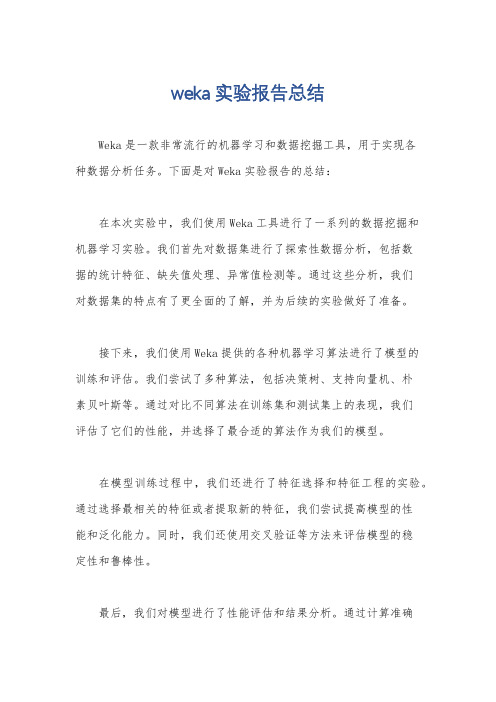
weka实验报告总结
Weka是一款非常流行的机器学习和数据挖掘工具,用于实现各
种数据分析任务。
下面是对Weka实验报告的总结:
在本次实验中,我们使用Weka工具进行了一系列的数据挖掘和
机器学习实验。
我们首先对数据集进行了探索性数据分析,包括数
据的统计特征、缺失值处理、异常值检测等。
通过这些分析,我们
对数据集的特点有了更全面的了解,并为后续的实验做好了准备。
接下来,我们使用Weka提供的各种机器学习算法进行了模型的
训练和评估。
我们尝试了多种算法,包括决策树、支持向量机、朴
素贝叶斯等。
通过对比不同算法在训练集和测试集上的表现,我们
评估了它们的性能,并选择了最合适的算法作为我们的模型。
在模型训练过程中,我们还进行了特征选择和特征工程的实验。
通过选择最相关的特征或者提取新的特征,我们尝试提高模型的性
能和泛化能力。
同时,我们还使用交叉验证等方法来评估模型的稳
定性和鲁棒性。
最后,我们对模型进行了性能评估和结果分析。
通过计算准确
率、召回率、F1值等指标,我们评估了模型的分类效果。
同时,我们还进行了误差分析,找出模型在分类错误的样本上的共同特征,以便进一步改进模型。
综上所述,本次实验中我们使用Weka工具进行了一系列的数据挖掘和机器学习实验。
通过探索性数据分析、模型训练和评估、特征选择和工程,以及性能评估和结果分析,我们得到了一个具有较好性能的模型,并对数据集有了更深入的理解。
这些实验为我们进一步研究和应用机器学习提供了有益的经验和启示。
如何使用Weka进行机器学习和数据挖掘

如何使用Weka进行机器学习和数据挖掘1. 引言机器学习和数据挖掘是当今计算机科学领域中非常热门的技术,它们的应用已经渗透到各个行业。
Weka是一个功能强大且易于使用的开源软件工具,广泛应用于机器学习和数据挖掘任务中。
本文将介绍如何使用Weka进行机器学习和数据挖掘,帮助读者快速上手。
2. 安装与配置Weka是使用Java编写的跨平台软件,可以在Windows、Linux 和Mac OS等操作系统上运行。
首先,从Weka官方网站上下载最新版本的Weka软件包。
下载完成后,按照官方提供的安装指南进行安装。
安装完成后,打开Weka软件,在"Tools"菜单下找到"Package Manager",确保所有必需的包(例如data-visualization)都已被安装。
3. 数据预处理在进行机器学习和数据挖掘任务之前,通常需要对原始数据进行预处理。
Weka提供了许多强大的工具来处理数据。
首先,可以使用Weka的数据编辑器加载并查看原始数据集。
然后,可以进行数据清洗,包括处理缺失值、异常值和重复数据等。
Weka还提供了特征选择和降维等功能,帮助提取有意义的特征。
4. 分类与回归分类和回归是机器学习中的两个重要任务。
Weka支持多种分类和回归算法,包括决策树、朴素贝叶斯、支持向量机和神经网络等。
在Weka主界面中,选择"Classify"选项卡,选择相应的算法,并配置参数。
然后,可以使用已经预处理的数据集进行模型训练和测试。
Weka提供了丰富的性能评估指标和可视化工具,帮助分析模型的效果。
5. 聚类分析聚类是一种无监督学习方法,用于将样本划分到不同的组或簇中。
Weka提供了各种聚类算法,如K均值、层次聚类和基于密度的聚类。
在Weka主界面中,选择"Cluster"选项卡,选择相应的算法,并配置参数。
然后,使用预处理的数据集进行聚类分析。
Weka_数据挖掘软件使用指南

Weka 数据挖掘软件使用指南1.Weka简介该软件是WEKA的全名是怀卡托智能分析环境(Waikato Environment for Knowledge Analysis),它的源代码可通过/ml/weka得到。
Weka作为一个公开的数据挖掘工作平台,集合了大量能承担数据挖掘任务的机器学习算法,包括对数据进行预处理,分类,回归、聚类、关联规则以及在新的交互式界面上的可视化。
如果想自己实现数据挖掘算法的话,可以看一看Weka的接口文档。
在Weka中集成自己的算法甚至借鉴它的方法自己实现可视化工具并不是件很困难的事情。
2.Weka启动打开Weka主界面后会出现一个对话框,如图:主要使用右方的四个模块,说明如下:❑Explorer:使用Weka探索数据的环境,包括获取关联项,分类预测,聚簇等;❑Experimenter:运行算法试验、管理算法方案之间的统计检验的环境;❑KnowledgeFlow:这个环境本质上和Explorer所支持的功能是一样的,但是它有一个可以拖放的界面。
它有一个优势,就是支持增量学习;❑SimpleCLI:提供了一个简单的命令行界面,从而可以在没有自带命令行的操作系统中直接执行Weka命令(某些情况下使用命令行功能更好一些)。
3.主要操作说明点击进入Explorer模块开始数据探索环境。
3.1主界面进入Explorer模式后的主界面如下:3.1.1标签栏主界面最左上角(标题栏下方)的是标签栏,分为五个部分,功能依次是:❑Preprocess(数据预处理):选择和修改要处理的数据;❑Classify(分类):训练和测试关于分类或回归的学习方案;❑Cluster(聚类):从数据中学习聚类;❑Associate(关联):从数据中学习关联规则;❑Select attributes(属性选择):选择数据中最相关的属性;❑Visualize(可视化):查看数据的交互式二维图像。
3.1.2载入、编辑数据标签栏下方是载入数据栏,功能如下:❑Open file:打开一个对话框,允许你浏览本地文件系统上的数据文件(.dat);❑Open URL:请求一个存有数据的URL 地址;❑Open DB:从数据库中读取数据;❑Generate:从一些数据生成器中生成人造数据。
weka实验报告

weka实验报告
Weka实验报告
Weka是一款流行的数据挖掘工具,它提供了丰富的机器学习算法和数据预处
理工具,使得数据分析和模型建立变得更加简单和高效。
在本次实验中,我们
将使用Weka工具进行数据分析和模型建立,以探索其在实际应用中的效果和
性能。
实验数据集选取了UCI机器学习库中的经典数据集“鸢尾花数据集”,该数据集
包含了150个样本,每个样本包括了4个特征和一个类别标签。
我们首先使用Weka进行数据预处理,包括缺失值处理、特征选择和数据变换等步骤,以保
证数据的质量和可用性。
接着,我们选择了几种常用的机器学习算法,包括决策树、支持向量机和K近
邻等,使用Weka进行模型建立和性能评估。
通过交叉验证和ROC曲线等方法,我们评估了不同算法在该数据集上的分类性能,并比较它们的准确度、召回率
和F1值等指标,以找出最适合该数据集的模型。
实验结果显示,Weka工具在数据预处理和模型建立方面表现出色,能够快速
高效地完成数据分析任务。
在鸢尾花数据集上,我们发现决策树算法和支持向
量机算法表现较好,能够达到较高的分类准确度和稳定性,而K近邻算法的性
能相对较差。
总的来说,Weka作为一款优秀的数据挖掘工具,具有丰富的功能和易用的界面,能够帮助用户快速建立和评估机器学习模型。
通过本次实验,我们对
Weka的性能和效果有了更深入的了解,相信它将在未来的数据分析工作中发
挥重要作用。
Weka开发[38]——参数优化(Optimizingparameters)
![Weka开发[38]——参数优化(Optimizingparameters)](https://img.taocdn.com/s3/m/1d31bccfb9f67c1cfad6195f312b3169a551ea53.png)
Weka开发[38]——参数优化(Optimizingparameters)翻译自Optimal parameters, 原地址:,这一篇我看到网上是有人译过的,但是我感觉他翻译的有的地方有些问题(比如对floor函数的翻译),并且没有译全,所以我又重译了,但我也不能保证我的翻译没有大问题,我以前没有怎么调过参数,因为我相信数据才是最大的问题。
因为寻找一个分类器的最优参数是一个很枯燥耗时的过程,所以Weka提供了一些有点自动化味道的方法,你可以用下面的两个meta-classifiers优化你的基分类器参数。
weka.classifiers.meta.CVParameterSelectionweka.classifiers.meta.GridSearch (only developer version)找到了可能的最优参数,meta-classifiers用这些参数训练一个基分类器,再用这个基分类器来预测。
CVParameterSelectionCVParameterSelection可以优化任意多个参数的基分类器,但它有一个缺点(如果不算参数的组合爆炸,Koala 译注:就是指参数所有可能的组合数太多,组合数举例来说,比如有两个参数,一个参数有2个取值,另一个参数有5个参数,可能的组合就是10个):它不能优化内嵌(nested)参数,只能优化基分类器的直接(directly)参数。
这是什么意思呢,这意味着,你可以优化weka.classifiers.functions.SMO的参数C,但你不能优化在weka.classifiers.meta.FilteredClassifier中的weka.classifiers.functions.SMO的参数C。
这有几个例子:J48 and it's confidence interval ("-C")1. 在Explorer中选择你的数据集。
weka总结

Weka总结引言Weka是一个免费、开源的数据挖掘和机器学习软件,于1997年首次发布。
它由新西兰怀卡托大学的机器学习小组开发,提供了一系列数据预处理、分类、回归、聚类和关联规则挖掘等功能。
本文将对Weka进行总结,并讨论其主要功能和优点。
主要功能1. 数据预处理Weka提供了各种数据预处理技术,用于数据的清洗、转换和集成。
最常用的预处理技术包括缺失值处理、离散化、属性选择和特征缩放等。
通过这些预处理技术,用户可以减少数据中的噪声和冗余信息,提高机器学习模型的性能。
2. 分类Weka支持多种分类算法,包括决策树、贝叶斯分类器、神经网络和支持向量机等。
用户可以根据自己的需求选择适当的算法进行分类任务。
Weka还提供了交叉验证和自动参数调整等功能,帮助用户评估和优化分类器的性能。
3. 回归除了分类,Weka还支持回归问题的解决。
用户可以使用线性回归、多项式回归和局部回归等算法,对给定的数据集进行回归分析。
Weka提供了模型评估和可视化工具,帮助用户理解回归模型和评估其预测性能。
4. 聚类Weka的聚类算法可用于将数据集中相似的样本归类到一起。
Weka支持K-means、DBSCAN、谱聚类和层次聚类等常用的聚类算法。
用户可以根据数据的特点选择适当的算法并解释聚类结果。
5. 关联规则挖掘关联规则挖掘是一种常见的数据挖掘任务,用于发现数据集中的频繁项集和关联规则。
通过Weka,用户可以使用Apriori和FP-growth等算法来挖掘数据中的关联规则。
Weka还提供了支持多种评估指标的工具,用于评估关联规则的质量和可信度。
优点1. 易于使用Weka的用户界面友好且易于使用。
它提供了直观的图形界面,使用户可以快速上手并进行各种数据挖掘任务。
此外,Weka还支持命令行操作,方便用户在脚本中使用和集成Weka的功能。
2. 强大的功能Weka提供了丰富的数据挖掘和机器学习功能,涵盖了数据预处理、分类、回归、聚类和关联规则挖掘等领域。
weka的apriori算法的实验总结及体会

一、前言Weka是一款流行的数据挖掘工具,其内置了多种经典的数据挖掘算法。
其中,Apriori算法是一种用于发现数据集中频繁项集的经典算法。
在本次实验中,我们将对Weka中的Apriori算法进行实验,并总结经验体会。
二、实验准备1. 数据集准备:选择一个符合Apriori算法输入要求的数据集,本次实验选取了一个包含购物篮信息的数据集,用于分析不同商品之间的关联规则。
2. Weka环境准备:确保Weka软件已经安装并能够正常运行。
三、实验步骤1. 数据集加载:我们将选取的数据集导入Weka软件中,确保数据集能够正确显示。
2. 参数设置:在Weka中,Apriori算法有一些参数需要设置,如最小支持度、最小置信度等。
根据实际需求,设置适当的参数。
3. 算法执行:执行Apriori算法,观察结果。
可以得到频繁项集、关联规则等信息。
4. 结果分析:根据算法输出的结果,分析不同项集之间的关联规则,并进行对比和总结。
四、实验结果1. 频繁项集分析:通过Apriori算法的执行,得到了数据集中的频繁项集信息。
可以发现一些商品之间的频繁组合,为进一步的关联规则分析提供了基础。
2. 关联规则分析:根据频繁项集,进一步推导出了一些关联规则。
如果购买了商品A,那么购买商品B的概率较大。
这对于商家进行商品搭配和促销活动有一定的指导作用。
3. 算法性能评估:除了得到具体的关联规则外,还可以对算法的性能进行评估。
包括算法执行时间、内存占用、参数敏感性等方面的评估。
五、实验体会1. 算法优缺点:经过实验,我们发现Apriori算法在处理大规模数据集时存在一定的计算复杂度,需要进行优化才能适应大规模数据挖掘的需求。
但在小规模数据集上,其表现仍然较为理想。
2. 参数选择经验:在实验中,我们也总结出了一些参数选择的经验,如支持度和置信度的合理选择范围,以及对于不同数据集的适应性。
3. 应用前景展望:关联规则挖掘在电商、市场营销等领域有着广泛的应用前景,我们相信在未来的实际工作中,能够将所学到的知识应用到真实的业务场景中。
机器学习工具WEKA的使用总结,包括算法选择、属性选择、参数优化

一、属性选择:1、理论知识:见以下两篇文章:数据挖掘中的特征选择算法综述及基于WEKA的性能比较_陈良龙数据挖掘中约简技术与属性选择的研究_刘辉2、weka中的属性选择2.1评价策略(attribute evaluator)总的可分为filter和wrapper方法,前者注重对单个属性进行评价,后者侧重对特征子集进行评价。
Wrapper方法有:CfsSubsetEvalFilter方法有:CorrelationAttributeEval2.1.1 Wrapper方法:(1)CfsSubsetEval根据属性子集中每一个特征的预测能力以及它们之间的关联性进行评估,单个特征预测能力强且特征子集内的相关性低的子集表现好。
Evaluates the worth of a subset of attributes by considering the individual predictive ability of each feature along with the degree of redundancy between them.Subsets of features that are highly correlated with the class while having low intercorrelation are preferred.For more information see:M. A. Hall (1998). Correlation-based Feature Subset Selection for Machine Learning. Hamilton, New Zealand.(2)WrapperSubsetEvalWrapper方法中,用后续的学习算法嵌入到特征选择过程中,通过测试特征子集在此算法上的预测性能来决定其优劣,而极少关注特征子集中每个特征的预测性能。
因此,并不要求最优特征子集中的每个特征都是最优的。
weka使用教程

weka使用教程Weka是一个强大的开源机器学习软件,它提供了各种功能和算法来进行数据挖掘和预测分析。
以下是一个简单的Wea使用教程,帮助您了解如何使用它来进行数据分析和建模。
1. 安装Weka:首先,您需要下载并安装Weka软件。
您可以从官方网站上下载Weka的最新版本,并按照安装说明进行安装。
2. 打开Weka:安装完成后,打开Weka软件。
您将看到一个欢迎界面,上面列出了各种不同的选项和功能。
选择“Explorer”选项卡,这将帮助您导航和执行不同的任务。
3. 导入数据:在Explorer选项卡上,点击“Open file”按钮以导入您的数据集。
选择您要导入的数据文件,并确认数据文件的格式和结构。
4. 数据预处理:在导入数据之后,您可能需要对数据进行预处理,以清除噪声和处理缺失值。
在Weka中,您可以使用各种过滤器和转换器来处理数据。
点击“Preprocess”选项卡,然后选择适当的过滤器和转换器来定义您的预处理流程。
5. 数据探索:在数据预处理之后,您可以使用Weka的可视化工具来探索您的数据。
点击“Classify”选项卡,然后选择“Visualize”选项。
这将显示您的数据集的可视化图表和统计信息。
6. 建立模型:一旦您对数据进行了足够的探索,您可以使用Weka的各种机器学习算法建立模型。
在“Classify”选项卡上选择“Choose”按钮,并从下拉菜单中选择一个适当的分类算法。
然后,使用“Start”按钮训练模型并评估模型的性能。
7. 模型评估:一旦您建立了模型,您可以使用Weka提供的评估指标来评估模型的性能。
在“Classify”选项卡上,选择“Evaluate”选项,Weka将自动计算模型的准确性、精确度、召回率等指标。
8. 导出模型:最后,一旦您满意您的模型性能,您可以将模型导出到其他应用程序或格式中。
在Weka中,点击“Classify”选项卡,选择“Save model”选项,并指定模型的保存位置和格式。
数据挖掘工具WEKA及其应用研究
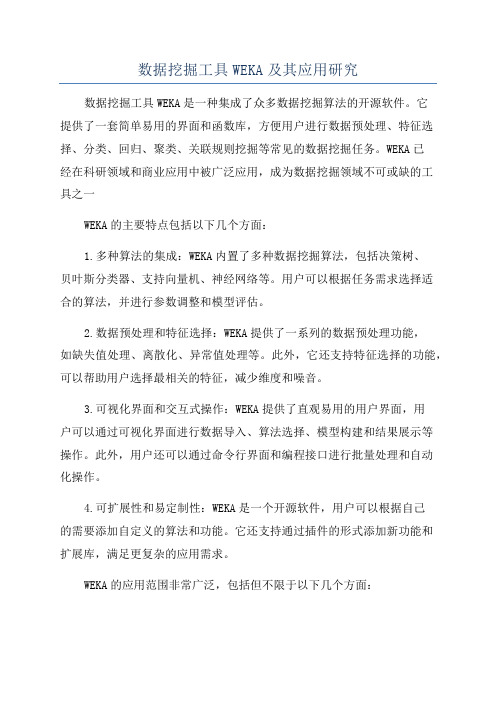
数据挖掘工具WEKA及其应用研究数据挖掘工具WEKA是一种集成了众多数据挖掘算法的开源软件。
它提供了一套简单易用的界面和函数库,方便用户进行数据预处理、特征选择、分类、回归、聚类、关联规则挖掘等常见的数据挖掘任务。
WEKA已经在科研领域和商业应用中被广泛应用,成为数据挖掘领域不可或缺的工具之一WEKA的主要特点包括以下几个方面:1.多种算法的集成:WEKA内置了多种数据挖掘算法,包括决策树、贝叶斯分类器、支持向量机、神经网络等。
用户可以根据任务需求选择适合的算法,并进行参数调整和模型评估。
2.数据预处理和特征选择:WEKA提供了一系列的数据预处理功能,如缺失值处理、离散化、异常值处理等。
此外,它还支持特征选择的功能,可以帮助用户选择最相关的特征,减少维度和噪音。
3.可视化界面和交互式操作:WEKA提供了直观易用的用户界面,用户可以通过可视化界面进行数据导入、算法选择、模型构建和结果展示等操作。
此外,用户还可以通过命令行界面和编程接口进行批量处理和自动化操作。
4.可扩展性和易定制性:WEKA是一个开源软件,用户可以根据自己的需要添加自定义的算法和功能。
它还支持通过插件的形式添加新功能和扩展库,满足更复杂的应用需求。
WEKA的应用范围非常广泛,包括但不限于以下几个方面:1.金融风控:WEKA可以用于分析和建立信用评分模型,帮助银行和金融机构评估客户信用风险,进行风险控制和信用决策。
2.医疗健康:WEKA可以用来分析医疗数据,挖掘疾病预测模型、生成患者分群和进行药物反应性分析等。
这有助于医生制定个体化治疗方案和改进医疗管理。
WEKA教程完整版(新)

@attribute <attribute-name> <datatype> 其中<attribute-name>是必须以字母开头的字符串。和关系名称一 样,如果这个字符串包含空格,它必须加上引号。
2021/3/7
CHENLI
10
2、数据格式(续)
❖ WEKA支持的<datatype>有四种
Format)文件,这是一种ASCII文本文件。上图所示的二维
表格存储在如下的ARFF文件中。这也就是WEKA自带的
“weather.arff”文件,在WEKA安装目录的“data”子目录下可
以找到。
2021/3/7
CHENLI
6
2021/3/7
CHENLI
7
2、数据格式(续)
❖ 文件内容说明 识别ARFF文件的重要依据是分行,因此不能在这种文 件里随意的断行。空行(或全是空格的行)将被忽略。 以“%”开始的行是注释,WEKA将忽略这些行。如果你 看到的“weather.arff”文件多了或少了些“%”开始的行, 是没有影响的。 除去注释后,整个ARFF文件可以分为两个部分。
2021/3/7
CHENLI
9
2、数据格式(续)
❖ 属性声明
属性声明用一列以“@attribute”开头的语句表示。数据集中的每一 个属性都有它对应的“@attribute”语句,来定义它的属性名称和数 据类型。
这些声明语句的顺序很重要。首先它表明了该项属性在数据部分 的位置。例如,“humidity”是第三个被声明的属性,这说明数据部 分那些被逗号分开的列中,第三列数据 85 90 86 96 ... 是相应的 “humidity”值。其次,最后一个声明的属性被称作class属性,在分 类或回归任务中,它是默认的目标变量。
基于weka的数据挖掘实验报告
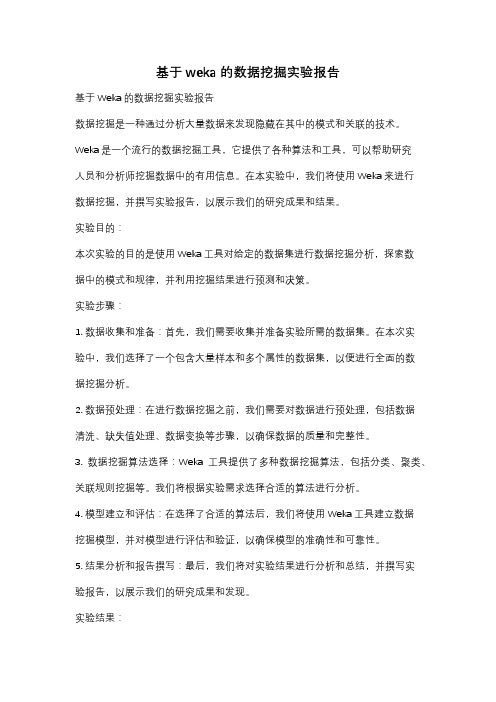
基于weka的数据挖掘实验报告基于Weka的数据挖掘实验报告数据挖掘是一种通过分析大量数据来发现隐藏在其中的模式和关联的技术。
Weka是一个流行的数据挖掘工具,它提供了各种算法和工具,可以帮助研究人员和分析师挖掘数据中的有用信息。
在本实验中,我们将使用Weka来进行数据挖掘,并撰写实验报告,以展示我们的研究成果和结果。
实验目的:本次实验的目的是使用Weka工具对给定的数据集进行数据挖掘分析,探索数据中的模式和规律,并利用挖掘结果进行预测和决策。
实验步骤:1. 数据收集和准备:首先,我们需要收集并准备实验所需的数据集。
在本次实验中,我们选择了一个包含大量样本和多个属性的数据集,以便进行全面的数据挖掘分析。
2. 数据预处理:在进行数据挖掘之前,我们需要对数据进行预处理,包括数据清洗、缺失值处理、数据变换等步骤,以确保数据的质量和完整性。
3. 数据挖掘算法选择:Weka工具提供了多种数据挖掘算法,包括分类、聚类、关联规则挖掘等。
我们将根据实验需求选择合适的算法进行分析。
4. 模型建立和评估:在选择了合适的算法后,我们将使用Weka工具建立数据挖掘模型,并对模型进行评估和验证,以确保模型的准确性和可靠性。
5. 结果分析和报告撰写:最后,我们将对实验结果进行分析和总结,并撰写实验报告,以展示我们的研究成果和发现。
实验结果:通过使用Weka工具进行数据挖掘分析,我们得到了一些有价值的挖掘结果和模型预测。
我们发现了数据中的一些隐藏模式和规律,并利用挖掘结果进行了一些预测和决策,为实验提供了有益的信息和见解。
结论:本次实验通过使用Weka工具进行数据挖掘分析,取得了一些有意义的研究成果和结果。
Weka工具提供了丰富的算法和工具,可以帮助研究人员和分析师挖掘数据中的有用信息,为决策和预测提供支持。
我们相信,通过不断的实验和研究,我们可以进一步挖掘数据中的更多有价值的信息和知识。
WEKA中文详细教程

Weka可以将分析结果导出为多种格式,如CSV、ARFF、LaTeX等,用户可以通过“文件”菜单 选择“导出数据”来导出数据。
数据清理
缺失值处理
Weka提供了多种方法来处理缺失值, 如删除含有缺失值的实例、填充缺失 值等。
异常值检测
Weka提供了多种异常值检测方法, 如基于距离的异常值检测、基于密度 的异常值检测等。
Weka中文详细教程
目录
• Weka简介 • 数据预处理 • 分类算法 • 关联规则挖掘 • 回归分析 • 聚类分析 • 特征选择与降维 • 模型评估与优化
01
Weka简介
Weka是什么
01 Weka是一款开源的数据挖掘软件,全称是 "Waikato Environment for Knowledge Analysis",由新西兰怀卡托大学开发。
解释性强等优点。
使用Weka进行决策树 分类时,需要设置合 适的参数,如剪枝策 略、停止条件等,以 获得最佳分类效果。
决策树分类结果易于 理解和解释,能够为 决策提供有力支持。
贝叶斯分类器
贝叶斯分类器是一种 基于概率的分类算法, 通过计算不同类别的 概率来进行分类。
Weka中的朴素贝叶斯 分类器是一种基于贝 叶斯定理的简单分类 器,适用于特征之间 相互独立的场景。
08
模型评估与优化
交叉验证
01
交叉验证是一种评估机器学习模型性能的常用方法,通过将数据集分成多个子 集,然后使用其中的一部分子集训练模型,其余子集用于测试模型。
02
常见的交叉验证方法包括k-折交叉验证和留出交叉验证。在k-折交叉验证中, 数据集被分成k个大小相近的子集,每次使用其中的k-1个子集训练模型,剩余 一个子集用于测试。
Weka的使用方法
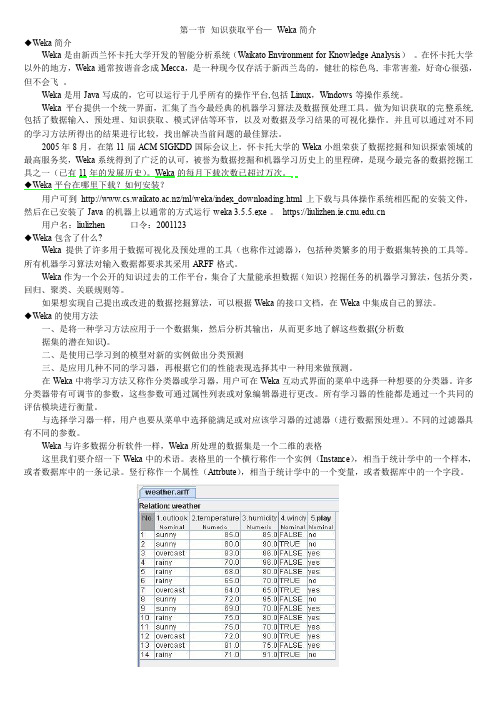
Stephen,Tyler,"7452 Terrace ""At the Plaza"" road",SomeTown,SD, 91234 ,Blankman,,SomeTown, SD, 00298 "Joan ""the bone"", Anne",Jet,"9th, at Terrace plc",Desert City,CO,00123 在这里,我们以 Excel 和 Matlab 为例,说明如何获得 CSV 文件。然后我们将知道 CSV 文件如何转化成 ARFF 文 件,面对一个 ARFF 文件,我们仍有一些预处理要做,才能进行挖掘任务。 MA TLAB 是由美国 MathWorks 公司推出的用于数值计算和图形处理计算系统环境, 除了具备卓越的数值计算能力 外, 它还提供了专业水平的符号计算, 文字处理, 可视化建模仿真和实时控制等功能. MA TLAB 的基本数据单位是矩阵, 它的指令表达式与数学, 工程中常用的形式十分相似, 故用 MA TLAB 来解算问题 要比用 C,FORTRAN 等语言简捷得多.MA TLAB 是国际公认的优秀数学应用软件之一. MA TLAB 是英文 MA Trix LABoratory( 矩阵实验室)的缩写.20 世纪 80 年代初期,Cleve Moler 与 John Little 等利用 C 语言开发了新一代的 MA T LAB 语言, 此时的 MA TLAB 语言已同时具备了数值计算功能和简单的图形处理功能.1984 年,Cleve Moler 与 John Little 等正式成立了 Mathworks 公司,把 MA TLAB 语言推向市场, 并开始了对 MA TLAB 工具箱等 的开发设计.1993 年,Mathworks 公司推出了基于个人计算机的 MA TLAB 4.0 版本, 到了 1997 年又推出了 MA TLAB 5.X 版 本(Release 11), 并在 2000 年推出 MA TLAB 6 版本(Release 12),2004 年 6 月份正式推出 MA TLAB 7.0 版本(Release 14). 在 Matlab 中的二维表格是一个矩阵, 我们通过这条命令把一个矩阵存成 CSV 格式。 csvwrite('filename',matrixname) 需要注意的是,Matlab 给出的 CSV 文件往往没有属性名( Excel 给出的也有可能没有) 。而 Weka 必须从 CSV 文 件的第一行读取属性名,否则就会把第一行的各属性值读成变量名。因此我们对于 Matlab 给出的 CSV 文件需要用 UltraEdit 打开,手工添加一行属性名。注意属性名的个数要跟数据属性的个数一致,仍用逗号隔开。 Excel 的 XLS 文件可以让多个二维表格放到不同的工作表(Sheet)中,我们只能把每个工作表存成不同的 CSV 文 件。打开一个 XLS 文件并切换到需要转换的工作表,另存为 CSV 类型,点“确定” 、 “是”忽略提示即可完成操作。 下面是 bank-data.xls( 是含 600 条实例的数据集)通过”另存为”转换成.csv 的例题 ◆在 Ultraedit 中打开的 bank-data.csv id,age,sex,region,income,married,children,car,save_act,current_act,mortgage,pep ID12101,48,FEMALE,INNER_CITY ,17546,NO,1,NO,NO,NO,NO,YES ID12102,40,MALE,TOWN,30085.1,YES,3,YES,NO,YES,YES,NO ID12103,51,FEMALE,INNER_CITY ,16575.4,YES,0,YES,YES,YES,NO,NO ID12104,23,FEMALE,TOWN,20375.4,YES,3,NO,NO,YES,NO,NO ID12105,57,FEMALE,RURAL,50576.3,YES,0,NO,YES,NO,NO,NO ID12106,57,FEMALE,TOWN,37869.6,YES,2,NO,YES,YES,NO,YES ID12107,22,MALE,RURAL,8877.07,NO,0,NO,NO,YES,NO,YES ID12108,58,MALE,TOWN,24946.6,YES,0,YES,YES,YES,NO,NO ID12109,37,FEMALE,SUBURBAN,25304.3,YES,2,YES,NO,NO,NO,NO ID12110,54,MALE,TOWN,24212.1,YES,2,YES,YES,YES,NO,NO ID12111,66,FEMALE,TOWN,59803.9,YES,0,NO,YES,YES,NO,NO ID12112,52,FEMALE,INNER_CITY ,26658.8,NO,0,YES,YES,YES,YES,NO ID12113,44,FEMALE,TOWN,15735.8,YES,1,NO,YES,YES,YES,YES ID12114,66,FEMALE,TOWN,55204.7,YES,1,YES,YES,YES,YES, YES ID12115,36,MALE,RURAL,19474.6,YES,0,NO,YES, YES, YES,NO
weka算法介绍
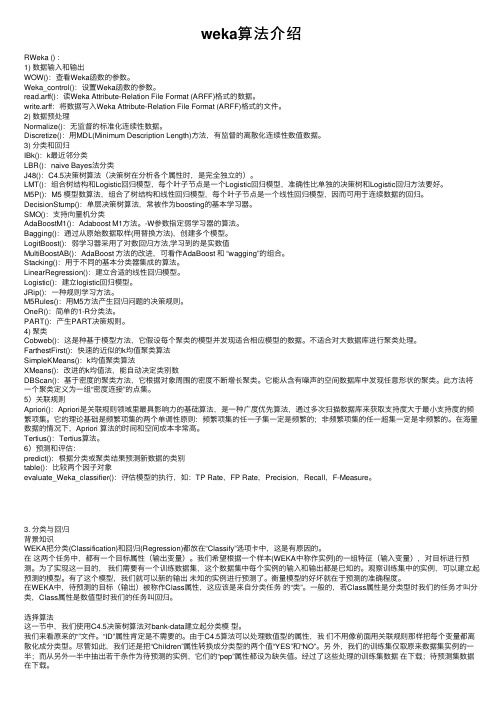
weka算法介绍RWeka () :1) 数据输⼊和输出WOW():查看Weka函数的参数。
Weka_control():设置Weka函数的参数。
read.arff():读Weka Attribute-Relation File Format (ARFF)格式的数据。
write.arff:将数据写⼊Weka Attribute-Relation File Format (ARFF)格式的⽂件。
2) 数据预处理Normalize():⽆监督的标准化连续性数据。
Discretize():⽤MDL(Minimum Description Length)⽅法,有监督的离散化连续性数值数据。
3) 分类和回归IBk():k最近邻分类LBR():naive Bayes法分类J48():C4.5决策树算法(决策树在分析各个属性时,是完全独⽴的)。
LMT():组合树结构和Logistic回归模型,每个叶⼦节点是⼀个Logistic回归模型,准确性⽐单独的决策树和Logistic回归⽅法要好。
M5P():M5 模型数算法,组合了树结构和线性回归模型,每个叶⼦节点是⼀个线性回归模型,因⽽可⽤于连续数据的回归。
DecisionStump():单层决策树算法,常被作为boosting的基本学习器。
SMO():⽀持向量机分类AdaBoostM1():Adaboost M1⽅法。
-W参数指定弱学习器的算法。
Bagging():通过从原始数据取样(⽤替换⽅法),创建多个模型。
LogitBoost():弱学习器采⽤了对数回归⽅法,学习到的是实数值MultiBoostAB():AdaBoost ⽅法的改进,可看作AdaBoost 和 “wagging”的组合。
Stacking():⽤于不同的基本分类器集成的算法。
LinearRegression():建⽴合适的线性回归模型。
Logistic():建⽴logistic回归模型。
JRip():⼀种规则学习⽅法。
weka使用教程

字符串属性和分类属性的值是区分大小写的.若值中含有空格,必须被引号括起来.例如: @relation LCCvsLCSH @attribute LCC string @attribute LCSH string @data AG5, 'Encyclopedias and dictionaries.;Twentieth century.' AS262, 'Science -- Soviet Union -- History.'
--
/~ml/weka/arff.html
/wekadoc/index.php/en:ARFF_%283.5.3%29 3.数据准备 数据准备 使用 WEKA 作数据挖掘,面临的第一个问题往往是我们的数据不是 ARFF 格式的.幸好,WEKA 还提供 了对 CSV 文件的支持,而这种格式是被很多其他软件所支持的.此外,WEKA 还提供了通过 JDBC 访问 数据库的功能. 在这一节里,我们先以 Excel 和 Matlab 为例,说明如何获得 CSV 文件.然后我们将知道 CSV 文件如何 转化成 ARFF 文件,毕竟后者才是 WEKA 支持得最好的文件格式.面对一个 ARFF 文件,我们仍有一些预 处理要做,才能进行挖掘任务.
weka使用报告
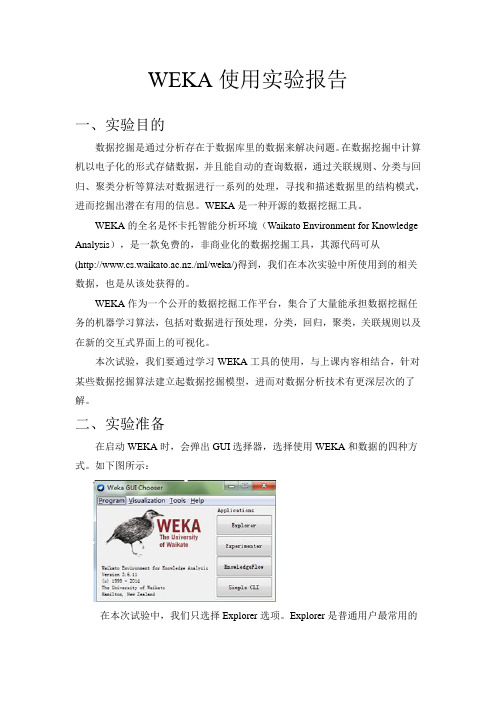
WEKA使用实验报告一、实验目的数据挖掘是通过分析存在于数据库里的数据来解决问题。
在数据挖掘中计算机以电子化的形式存储数据,并且能自动的查询数据,通过关联规则、分类与回归、聚类分析等算法对数据进行一系列的处理,寻找和描述数据里的结构模式,进而挖掘出潜在有用的信息。
WEKA是一种开源的数据挖掘工具。
WEKA的全名是怀卡托智能分析环境(Waikato Environment for Knowledge Analysis),是一款免费的,非商业化的数据挖掘工具,其源代码可从(./ml/weka/)得到,我们在本次实验中所使用到的相关数据,也是从该处获得的。
WEKA作为一个公开的数据挖掘工作平台,集合了大量能承担数据挖掘任务的机器学习算法,包括对数据进行预处理,分类,回归,聚类,关联规则以及在新的交互式界面上的可视化。
本次试验,我们要通过学习WEKA工具的使用,与上课内容相结合,针对某些数据挖掘算法建立起数据挖掘模型,进而对数据分析技术有更深层次的了解。
二、实验准备在启动WEKA时,会弹出GUI选择器,选择使用WEKA和数据的四种方式。
如下图所示:在本次试验中,我们只选择Explorer选项。
Explorer是普通用户最常用的一个界面。
用户可以从ARFF文件(WEKA使用的一种文本文件格式)或网页或数据库中读取数据集。
打开数据文件后,可以选择算法对数据进行预处理。
这时窗体上给出了这个数据集的一些基本特征,如含有多少属性,各属性的一些简单统计量,右下方还给出一些可视化效果图。
这些都是比较直观的分析,如果想发现隐藏在数据集背后的关系,还需要选择WEKA提供的各种分类、聚类或关联规则的算法。
界面如下图所示:上图是打开Explorer界面,导入软件自身所带的训练集“segment.arff”文件后所呈现的界面。
我们也可以查看该训练集中的数据,如下图所示:三、实验内容1.贝叶斯算法点“Choose”按钮选择“bayes”,这是WEKA中实现的贝叶斯算法。
weka操作介绍

1 2 3 4
6
7 5
8
1.区域1的几个选项卡是用来切换不同的 挖掘任务面板。assify(分类)
Cluster(聚类) Associate(关联分析) Select Attributes(选择属性)
Visualize(可视化)
2. 区域2是一些常用按钮。包括打开数据, 保存及编辑功能。我们可以在这里把 “bank-data.csv”,另存为“bank-data.arff”
WEKA 操作介绍
命令环境
算法实验环境
知识流环境
在KnowledgeFlow 窗口顶部有八个标签: DataSources--数据载入器 DataSinks--数据保存器 Filters--筛选器 Classifiers--分类器 Clusterers--聚类器 Associations—关联器 Evaluation—评估器 Visualization—可视化
Cluster
右击左侧栏result list,点“Visualize cluster assignments”。 弹出的窗口给出了各实例的散点图。
Associate 设置参数 car:如果设为真,则会挖掘类关联规则而不是全 局关联规则。 classindex: 类属性索引。如果设置为-1,最后的 属性被当做类属性。 delta: 以此数值为迭代递减单位。不断减小支持 度直至达到最小支持度或产生了满足数量要求的 规则。 lowerBoundMinSupport: 最小支持度下界。 metricType: 度量类型,设置对规则进行排序的 度量依据。可以是:置信度(类关联规则只能用 置信度挖掘),提升度(lift),平衡度(leverage), 确信度(conviction)。 minMtric :度量的最小值。 numRules: 要发现的规则数。 outputItemSets: 如果设置为真,会在结果中输 出项集。 removeAllMissingCols: 移除全部为缺失值的列。 significanceLevel :重要程度。重要性测试(仅用 于置信度)。 upperBoundMinSupport: 最小支持度上界。 从这 个值开始迭代减小最小支持度。 verbose: 如果设置为真,则算法会以冗余模式运 行。
weka实验报告总结 -回复
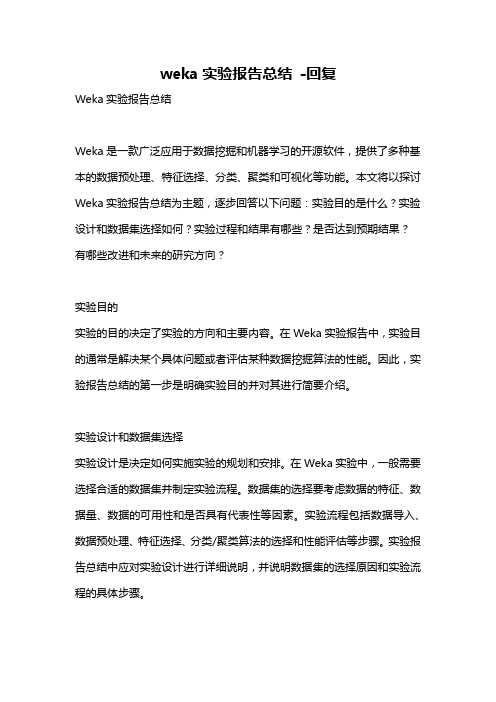
weka实验报告总结-回复Weka实验报告总结Weka是一款广泛应用于数据挖掘和机器学习的开源软件,提供了多种基本的数据预处理、特征选择、分类、聚类和可视化等功能。
本文将以探讨Weka实验报告总结为主题,逐步回答以下问题:实验目的是什么?实验设计和数据集选择如何?实验过程和结果有哪些?是否达到预期结果?有哪些改进和未来的研究方向?实验目的实验的目的决定了实验的方向和主要内容。
在Weka实验报告中,实验目的通常是解决某个具体问题或者评估某种数据挖掘算法的性能。
因此,实验报告总结的第一步是明确实验目的并对其进行简要介绍。
实验设计和数据集选择实验设计是决定如何实施实验的规划和安排。
在Weka实验中,一般需要选择合适的数据集并制定实验流程。
数据集的选择要考虑数据的特征、数据量、数据的可用性和是否具有代表性等因素。
实验流程包括数据导入、数据预处理、特征选择、分类/聚类算法的选择和性能评估等步骤。
实验报告总结中应对实验设计进行详细说明,并说明数据集的选择原因和实验流程的具体步骤。
实验过程和结果实验过程是实验的具体操作步骤,实验结果是根据实验数据计算得出的评估结果。
在Weka实验中,实验过程包括数据导入、数据预处理、特征选择和分类/聚类算法等操作步骤,通过Weka软件的各个模块实现。
实验结果要包括分类/聚类的准确率、召回率、F1值等评估指标,并与其他算法或者基准进行对比。
实验报告总结中应对实验过程和结果进行详细叙述,并给出相应的图表和分析。
达到预期结果与改进方向通过对实验结果的分析,可以判断实验是否达到预期结果。
如果实验结果达到了预期目标,可以进行相应的分析和总结;如果未达到预期目标,则需要分析原因,并提出改进方案。
改进方案可以包括尝试不同的数据集、调整特征选择的参数、尝试其他分类/聚类算法等。
实验报告总结中应对是否达到预期结果以及改进方向进行详细叙述,并给出相应的分析和建议。
未来的研究方向最后,在Weka实验报告总结中应提出未来的研究方向。
- 1、下载文档前请自行甄别文档内容的完整性,平台不提供额外的编辑、内容补充、找答案等附加服务。
- 2、"仅部分预览"的文档,不可在线预览部分如存在完整性等问题,可反馈申请退款(可完整预览的文档不适用该条件!)。
- 3、如文档侵犯您的权益,请联系客服反馈,我们会尽快为您处理(人工客服工作时间:9:00-18:30)。
一、属性选择:1、理论知识:见以下两篇文章:数据挖掘中的特征选择算法综述及基于WEKA的性能比较_陈良龙数据挖掘中约简技术与属性选择的研究_刘辉2、weka中的属性选择2.1评价策略(attribute evaluator)总的可分为filter和wrapper方法,前者注重对单个属性进行评价,后者侧重对特征子集进行评价。
Wrapper方法有:CfsSubsetEvalFilter方法有:CorrelationAttributeEval2.1.1Wrapper方法:(1)CfsSubsetEval根据属性子集中每一个特征的预测能力以及它们之间的关联性进行评估,单个特征预测能力强且特征子集内的相关性低的子集表现好。
Evaluates the worth of a subset of attributes by considering the individual predictive ability of each feature along with the degree of redundancy between them.Subsets of features that are highly correlated with the class while having low intercorrelation are preferred.For more information see:M.A.Hall(1998).Correlation-based Feature Subset Selection for Machine Learning.Hamilton,New Zealand.(2)WrapperSubsetEvalWrapper方法中,用后续的学习算法嵌入到特征选择过程中,通过测试特征子集在此算法上的预测性能来决定其优劣,而极少关注特征子集中每个特征的预测性能。
因此,并不要求最优特征子集中的每个特征都是最优的。
Evaluates attribute sets by using a learning scheme.Cross validation is used to estimate the accuracy of the learning scheme for a set of attributes.For more information see:Ron Kohavi,George H.John(1997).Wrappers for feature subset selection. Artificial Intelligence.97(1-2):273-324.2.1.2Filter方法:如果选用此评价策略,则搜索策略必须用Ranker。
(1)CorrelationAttributeEval根据单个属性和类别的相关性进行选择。
Evaluates the worth of an attribute by measuring the correlation(Pearson's) between it and the class.Nominal attributes are considered on a value by value basis by treating each value as an indicator.An overall correlation for a nominal attribute is arrived at via a weighted average.(2)GainRatioAttributeEval根据信息增益比选择属性。
Evaluates the worth of an attribute by measuring the gain ratio with respect to the class.GainR(Class,Attribute)=(H(Class)-H(Class|Attribute))/H(Attribute).(3)InfoGainAttributeEval根据信息增益选择属性。
Evaluates the worth of an attribute by measuring the information gain with respect to the class.InfoGain(Class,Attribute)=H(Class)-H(Class|Attribute).(4)OneRAttributeEval根据OneR分类器评估属性。
Class for building and using a1R classifier;in other words,uses the minimum-error attribute for prediction,discretizing numeric attributes.For more information,see:R.C.Holte(1993).Very simple classification rules perform well on most commonly used datasets.Machine Learning.11:63-91.(5)PrincipalComponents主成分分析(PCA)。
Performs a principal components analysis and transformation of the e in conjunction with a Ranker search.Dimensionality reduction is accomplished by choosing enough eigenvectors to account for some percentage of the variance in the original data---default0.95(95%).Attribute noise can be filtered by transforming to the PC space,eliminating some of the worst eigenvectors,and then transforming back to the original space.(6)ReliefFAttributeEval根据ReliefF值评估属性。
Evaluates the worth of an attribute by repeatedly sampling an instance and considering the value of the given attribute for the nearest instance of the same and different class.Can operate on both discrete and continuous class data.For more information see:Kenji Kira,Larry A.Rendell:A Practical Approach to Feature Selection.In: Ninth International Workshop on Machine Learning,249-256,1992.Igor Kononenko:Estimating Attributes:Analysis and Extensions of RELIEF.In: European Conference on Machine Learning,171-182,1994.Marko Robnik-Sikonja,Igor Kononenko:An adaptation of Relief for attribute estimation in regression.In:Fourteenth International Conference on Machine Learning,296-304,1997.(7)SymmetricalUncertAttributeEval根据属性的对称不确定性评估属性。
Evaluates the worth of an attribute by measuring the symmetrical uncertainty with respect to the class.SymmU(Class,Attribute)=2*(H(Class)-H(Class|Attribute))/H(Class)+ H(Attribute).2.2搜索策略(Search Method)2.2.1和评价策略中的wrapper方法对应(1)BestFirst最好优先的搜索策略。
是一种贪心搜索策略。
Searches the space of attribute subsets by greedy hillclimbing augmented with a backtracking facility.Setting the number of consecutive non-improving nodes allowed controls the level of backtracking done.Best first may start with the empty set of attributes and search forward,or start with the full set of attributes and search backward,or start at any point and search in both directions(by considering all possible single attribute additions and deletions at a given point).(2)ExhaustiveSearch穷举搜索所有可能的属性子集。
Performs an exhaustive search through the space of attribute subsets starting from the empty set of attrubutes.Reports the best subset found.(3)GeneticSearch基于Goldberg在1989年提出的简单遗传算法进行的搜索。
Performs a search using the simple genetic algorithm described in Goldberg (1989).For more information see:David E.Goldberg(1989).Genetic algorithms in search,optimization and machine learning.Addison-Wesley.(4)GreedyStepwise向前或向后的单步搜索。
